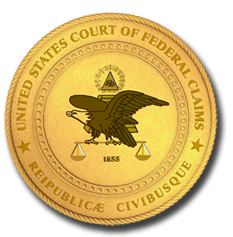Message From The Chief Judge
On March 13, 2017, I received notice that the President of the United States designated me as Chief Judge of the U.S. Court of Federal Claims. After serving on the bench for 13 years it will not surprise you that I have thought about the role of the Chief for some time. I view my role as a temporary steward of a judicial institution that has made an important mark in the jurisprudence of the Nation, but my interest is in the future of the Court.
Toward that end, I did not move into the Chief’s Office nor have a "passing of the gavel" ceremony. I have worked for 13 years in the smallest Chambers with a lean litigating team of clerks, interns, and judicial assistants to adjudicate cases in an efficient and, hopefully substantively correct way. I do not intend to change our work environment or productivity. My door is always open and the lights are on late. I have divested a great deal of the management functions of the Court into teams of junior and more experienced judges, so they learn together to manage the Court in a transparent manner. I intend to rotate these teams every year, so that all the judges learn every aspect of the Court’s business. I have formed the Court’s first Budget Committee that will provide the Court with reports at least four times a year so that we all know exactly how our budget is utilized. I have formed one Committee to search for a permanent Clerk of the Court and another to search for a new Vaccine Special Master. I have worked with Chief Special Master Dorsey to increase the Office of Special Masters’ budget allotment for 2018. The Judge’s Meetings will be every month, not only 9 times a year. Before each meeting, every relevant Management Committee prepares a one page written report of their activities that is circulated before the Judges’ meeting with an agenda. All of this information is placed in a notebook in the Clerk’s Office, so that anyone in the Court may know what is going on at all times. I have recalled 8 Senior Judges to service and provided them with full staffing and other support. They have been recalled with very specific requirements about productivity expectations. All of the Judges are now assigned to receive bid protests from the wheel---in sickness and in health, whether near or far away. A new monthly case management system that is controlled by staff in the Clerk’s Office has been implemented. All of this has happened in less than 3 months. And, yes, I cancelled the Judicial Conference and bi-annual meeting of the Court’s Advisory Council. I hope to work with the Bar Association to reschedule these events in the fall or spring of 2018 at a fabulous and more cost-effective conference venue at Mt. Vernon, where the Federal Judicial Center holds such events.
Change is never easy. But change is necessary for growth. I am pleased to see firsthand the strength of the Clerk’s Office and the response of the judges to the challenges ahead. At present, the Court has 6 vacancies, and if no new judges are nominated and confirmed by July of 2018, we will have 11 vacancies. In light of budget constraints inhibiting the creation of new Article III judgeships and the overburdened dockets of many courts around the country, with a consensus of the judges, I have initiated a project to restore the Court to Article III status. This process, if it is successful, will take some time and will likely encounter hurdles both known and unknown. But to date, I am moderately optimistic that this goal can be achieved down the road if we proceed in a thoughtful and transparent manner. Towards this end, at present five different Committees of the Judicial Conference of the United States are reviewing a package, including a draft bill, that I forwarded to the Administrative Office in early May. That review will take several months. In the interim, I am working with the Administrative Office’s Budget Team to ascertain how this proposal will be scored by the Congressional Budget Office. Nothing in the Court’s day-to-day work, however, has changed. There will be a time for public participation but, for now, the Court’s focus is to respond to Judicial Conference Committee inquiries and remain flexible as we work through this process together. With a full complement of 16 Active Judges and 10 or so Senior Judges with Article III status, the Court will not only be able to continue to adjudicate its current docket, but it will also be in a position to make a significant contribution to district courts that need additional working hands. It will enable the Department of Justice to elect to initiate False Claims Act and similar cases in our Court and will place the United States Court of Federal Claims in parity with the United States Court of International Trade, under the appellate jurisdiction of the United States Court of Appeals for the Federal Circuit. Finally, this effort should not entail any additional cost to the public but, more importantly, it will integrate the United States Court of Federal Claims into the federal judiciary as a whole today and for the years ahead. Onward.
Susan
